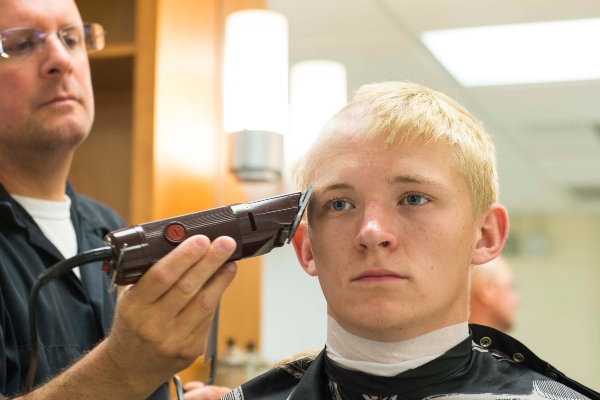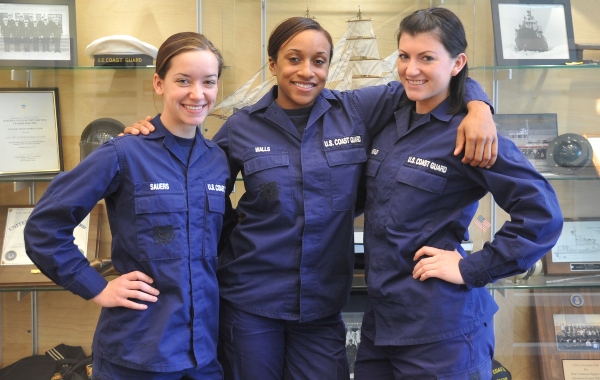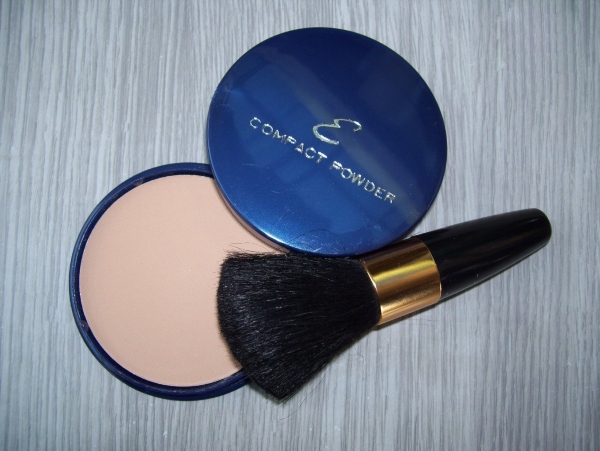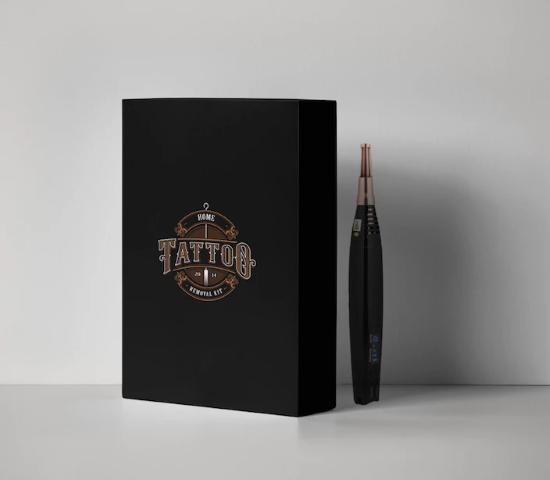The U.S. Coast Guard (USCG) acts as the defense on America’s coasts.
It’s one of seven uniformed services in the U.S. Military.
The Coast Guard has grooming standards like every other branch of the Armed Forces, such as the Navy, Army, and Marine Corps.
The military is notorious for having very high expectations when it comes to personal grooming.
It includes basic hygiene as well as haircut regulations, body art, piercings, tattoos, and rules for the uniform.
What are the Coast Guard grooming standards? Read more to get all the details!
Related Article – Navy Grooming Standards
Jump To A Section
Coast Guard Grooming Standards
Beard And Mustache Regulations
Coast Guard Grooming Standards

The U.S. Coast Guard currently has over 41,000 men and women on active duty, and another 7,000 that act as reservists.
All members of the Coast Guard are expected to follow the grooming standards outlined in the U.S. Department of Homeland Security – Coast Guard Manual.
The manual notes that “grooming standards are based on several elements including neatness, cleanliness, safety, military image, and appearance”.
As a result, anything that is used to alter the appearance of an individual that does not keep consistent with the “customs, traditions, and spirit of military appearance” are deemed unacceptable.
It includes items like
- Radical hair colors or styles
- Outlandish cosmetics
- Colored contact lenses
- Tattoos
- Body piercings
- Fingernail colors
- Intentional scarring
These take away from a consistent military image.
The Coast Guard likes to explain to new members that their image should always resemble the portrait on their official ID military card.
Why?
The photo is taken when the service member first joins the Coast Guard and is current with personal grooming standards and expectations.
If the image does become drastically different he or she needs to collect a new military ID with the updated photo (considering the appearance is still within acceptable standards).
Coast Guard Hair Regulations
The Coast Guard explains that it is “impossible to provide examples of every appropriate or unacceptable hairstyle or conservative or eccentric grooming” standard.
Therefore, it is the responsibility of leaders to exercise good judgment and uphold the Coast Guard grooming standards.
Military leaders are asked to determine the appropriateness of any hairstyle based on its appearance when headgear is worn.
Related Article: Coast Guard Height And Weight Requirements
One common theme you will find with every branch of the military is that they make no exceptions if the hairstyle prevents headgear from fitting snugly or correctly.
There is zero tolerance for headgear that is distorted or has excessive gaps because it is a safety hazard.
The Coast Guard states that hair is not allowed to be visible under the front brim (combination or ball cap) of headgear.
It also may not extend beyond the forward point of the garrison cap.
Additionally, designated Coast Guard leaders are allowed to establish more restrictive grooming standards for enlisted recruits, cadets, and officer candidates.
General Coast Guard Hair Guidelines
According to the Coast Guard manual, general haircut standards include:
- Hair that is clean, well-groomed, and neat.
- Hair must not touch the eyebrows when groomed or extend below the front of headgear.
- No shaved decorative patterns or sections on the scalp.
- Only natural hair color is approved. Not excessive colors like pink, green, or purple.
- Highlights need to blend well and not cause a distraction.
Related Article – Air Force Grooming Standards: Haircuts, Mustaches, Beards, And More
Hair Regulations for Men

Men have fewer guidelines for their hair compared to female personnel:
- Clean, completely shaved scalps are allowed.
- Hair must stay above the ears. Around the neck need to get tapered from the lower natural hairline upwards at least 3/4 inch and outward no longer than 3/4 inch.
- Hair is not allowed to block across the back of the neck. It also cannot touch the collar.
- The length of the hair cannot exceed 4 inches and the bulk no more than 1.5 inches from the scalp.
- Hair must not touch the ears or collar, extend below the eyebrows, or show under the front edge of headgear.
Related Article: Coast Guard Age Limit
Hair Regulations for Women

Women that serve in the U.S. Armed Forces have more guidelines to follow with hairstyles since their hair is normally longer and there are so many different styles.
The official policy notes:
- Hair that is clean, well-groomed, and neat.
- No ragged or unkempt appearances.
- Only natural hair coloring.
- Hair may touch yet not fall below a horizontal level with the bottom edge of the back shirt or jacket collar. The exception is a foul-weather parka.
- Bangs may not extend below the eyebrows.
- No portion of the hair bulk when measured from the scalp shall exceed 3.5 inches. The exception is a bun which is granted a maximum of 4 inches from the scalp and no wider than the width of the head.
- Hair accessories may not add more than 3.5 inches of bulk (4 inches with buns) or interfere with the proper use of headgear.
- Hair that traditionally falls below the lower edge of a collar must get tied into a ponytail, regardless of length. It also must be “neatly and inconspicuously fastened, pinned, or secured”. Bottom line the hair can’t swing freely.
- Commanders may restrict the use of hair accessories when engaged in operations where there is a risk of personal safety or FOD hazard.
There are varying standards for specialized types of female haircuts like cornrows, weaves, multiple braids, hair extensions, and micro-braids.
If you currently have one of those types of hairstyles you should consult the manual for additional details.
Related Article: 5 Best Coast Guard Jobs
Unauthorized Female Hairstyles
There are a few hairstyles that are not permitted in the U.S. Coast Guard:
- Lopsided hairstyles.
- Pigtails that protrude from the scalp.
- Extremely asymmetrical hairstyles.
- Widely spaced individual hanging braids or locks.
- Single braids that go down only one side of the head.
Additionally, these hair accessories are not allowed in the Coast Guard:
- Sweatbands
- Headbands
- Lacy scrunchies
- Beads
- Decorative pins or barrettes
- Bows
- Foreign material (i.e. ribbons) that are woven into the hair
The Coast Guard allows wigs and cosmetics with specified criteria. Wigs are authorized if they are of good quality.
The Coast Guard demands a “conservative style” that conforms to the rest of the female hair standards.
NOTE: A single wingless hair claw is allowed in the Coast Guard. The wingless claw must closely match the hair of the service member. It also cannot exceed three inches in length and one inch in width.
Related Article: List Of Coast Guard Bases In The US
Coast Guard Beard and Mustache Regulations

The Coast Guard is similar to other branches of the military in how it enforces facial hair.
In general, the only type of facial hair that is permitted is mustaches as well as sideburns:
- Mustaches must be neatly groomed.
- The mustache may not extend below the top of the upper lip or beyond the corners of the mouth.
- Sideburns are allowed if they are even width and end with a horizontal line.
- The sideburns must get tapered to conform to the rest of the hair.
- Sideburns may not extend below a point level with the bottom of the ear opening.
Beards are not allowed. The only exception is if you are granted a shaving waiver. The waivers are normally given to personnel with a PFB diagnosis.
NOTE: Coast Guard recruits, cadets, officer candidates, and ceremonial honor Guard members are not allowed to have facial hair of any kind!
Related Article: 18 Pros And Cons Of Joining The Coast Guard
Coast Guard Policy on Piercings
The Coast Guard does not have as much information about body art and piercings as other branches of the U.S. Military.
The manual states that “personnel should consult with their chain of command before considering a tattoo, piercing, or body modification”.
Reference (d) in the Coast Guard grooming standards policy has a few more details:
- Coast Guard personnel are advised to consult about any new piercing or tattoo before getting it done on the body.
- Existing body piercings and tattoos could get “grandfathered in” depending on personal circumstances.
The Coast Guard, like other branches of the military, recently loosened some of its standards for body art.
Though the rules on body piercings are still fairly straightforward, some more leeway is being granted.
In general, body piercings visible when in uniform are prohibited.
Related Article: Coast Guard PT Test Standards
Body piercings that are concealed by a uniform are highly discouraged for medical reasons.
No body jewelry may show through the uniform.
Ear piercing for both men and women is permitted, up to two piercings per early lobe, with no gauging.
However, only women may wear one earring per ear with the uniform. Men may not wear earrings in uniform or on a military installation.
Women’s earrings in uniform must be 4-6mm ball studs of white diamond, gold, silver, or white pearl finish.
Other Regulations – Fingernails, Cosmetics, etc
Fingernails are closely scrutinized by the U.S. Military.
There are standards for men and women:
- Men: The policy is straightforward. Keep them clean and make sure they do not extend past the fingertips. No coloring is allowed.
- Women: The policy is a little more loose to accommodate women. Fingernails must get rounded or square-shaped at the tips. Only one color may be worn. Wearing of “fluorescent” or multi-colored polishes is not authorized. The exception are French manicures with a white tip only. Additionally, the nails cannot extend more than 1/4 inch beyond the fingertip. Decorative nails are not permitted.
Related Article – Coast Guard Ranks And Pay
Cosmetics are allowed only if they provide a natural look and are in “good taste”.
The makeup may not contain bright colors like green, yellow, blue, or orange.

Tattoos
We actually have a full article on the Coast Guard tattoo policy here.
Read that article to get the most up-to-date info on what tattoos you can have, and which ones you can’t!
If you’re looking for a cost-effective, at home, DIY type of tattoo removal for any branch of the U.S. military, check out our review of this tattoo removal laser pen kit.
It’s a safe and convenient alternative to expensive visits to a laser tattoo removal professional service.
Conclusion
The Coast Guard enforces strict grooming standards though some more leeway has recently been granted to female service members, as well as regarding body art like tattoos.
When you first join the Coast Guard, new recruits and cadets must remain completely clean-shaven as well as maintain a clean and neat appearance.
Make sure you do not fool around with this absolute guideline!
Related Article: How To Join The Coast Guard
Resources:
- https://media.defense.gov/2018/Dec/13/2002072299/-1/-1/0/CIM_1020_6J.PDF
- https://www.thebalancecareers.com/tattoo-body-art-and-brands-policy-coast-guard-3356732
- https://wow.uscgaux.info/content.php?unit=091-16&category=standards-and-grooming
- https://wow.uscgaux.info/content.php?unit=130-07-08&category=changes-to-uniform-regs
- Coast Guard Grooming Standards - June 17, 2024
- Attending the Naval Academy Preparatory School - June 17, 2024
- Vet Tix Review: Your Go-To Guide - June 17, 2024





